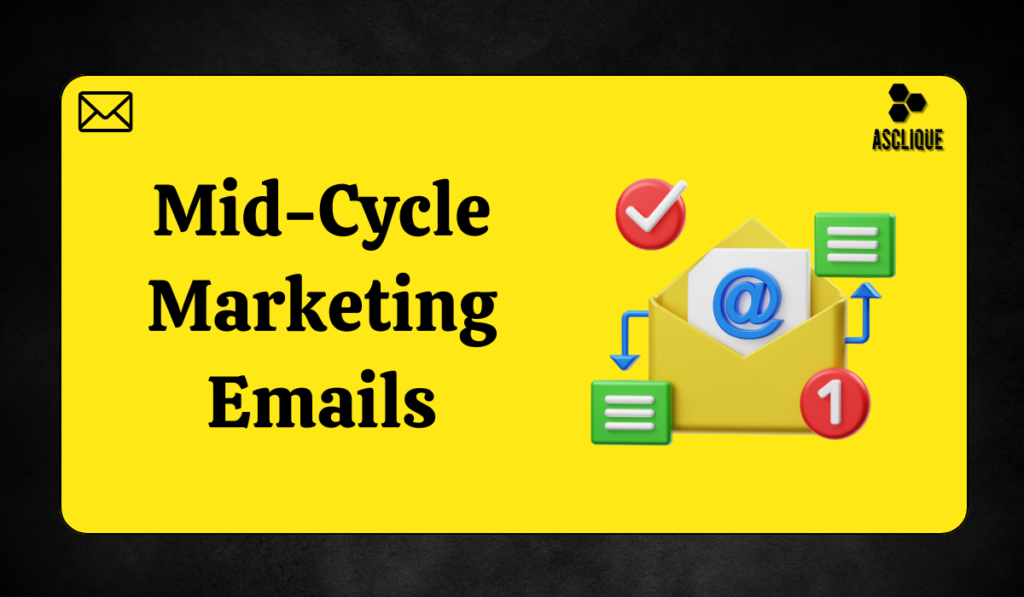In the fast world of digital marketing, the right email at the right time can make all the difference. Everyone focuses on initial and final sales emails, but mid-cycle marketing emails are often unsung heroes that nurture leads toward making a decision.
These emails are right in the middle where the introduction and the close goes; this keeps your reader on the hook and also informed. What is a mid cycle marketing email, however? This article takes a step to look at why mid-cycle marketing emails are important, their benefits, and how that often-overlooked word at the bottom can be very effective for conversions.
What is a Mid-Cycle Marketing Email?
A mid-cycle marketing email is sent in the middle of the sales or marketing cycle. It is neither a front-line introduction nor a last push but rather a middle ground to bring informative content, updates, or special offers to keep interested parties interested. Here, one’s focus is on establishing a relationship, rather than annoying people with constant pitches.
For instance, if your discount is for one month, your first email may be the announcement of your discount, and your last email can create a need for haste. A middle-of-cycle email can discuss new features introduced with your offer, events, or success stories of other customers who had applied the offer in the past.
Why Mid-Cycle Marketing Emails Matter for Your Campaign
Mid-cycle emails are important as brands remind their audience in a less annoying way. This is why they are important:
- Keeps interest alive: Mid-cycle emails can also be like a gentle reminder about your product or service in the minds of your prospects.
- Builds trust over time: Consistent communication sets up a relationship with the receiver, therefore, bringing in the chances for conversion.
- Increases conversion opportunities: This increases the opportunities for conversion. Moreover, statistics show that 50% of customers would want to do more business with the company that provides relevant content throughout the sales cycle.
You are going to appear as a viable source of information to your lead regularly. This puts you in an easier position to receive high sales when the time is right.
Different Types of Mid-Cycle Marketing Emails to Consider
Not all middle-cycle emails are created equal. Here are some examples you can use, depending on your campaign:
- Product Updates and Feature Releases: Keep current users up to date with new features or updates on a product.
- Customer Success Stories and Testimonials: Tell users how you have helped others.
- Event Invitations or Reminders: Now remind them of webinars or other virtual events they might be interested in attending.
- Exclusive Promotions or Discounts: You can provide them with some limited-edition offers or special discount deals for loyal subscribers.
- Educational Content: Give them some useful tips or industry insights related to your product or service, hence gaining a position as a thought leader.
Benefits of Mid-Cycle Marketing Emails
So, why should you be sending mid-cycle marketing emails? Here’s what you stand to gain:
- Improved engagement: Emails sent mid cycle keep your target interested without overwhelming him or her.
- Build stronger relationships: Delivering value to your audience during other stages apart from the start and end is what forms trust and makes your audience feel valued.
- Boost conversions: Engaged customers are more likely to purchase when they perceive that they are receiving valid and relevant information.
According to HubSpot, marketers in mid-cycle who utilize segmented email campaigns find that revenue results in a 760% increase. This is the true significance of providing pertinent and focused content over the duration of the customer’s journey.
Key Elements of an Effective Mid-Cycle Email
What’s the secret behind an effective mid-cycle email? Here’s the breakdown of what’s in every email to ensure it’s engaging and effective:
| Element | Purpose |
| Subject Line | Captures attention and encourages recipients to open. |
| Personalization | Makes the email feel unique and tailored to the reader. |
| Value-Driven Content | Offers something of value, such as information or offers. |
| Call-to-Action (CTA) | Directs readers to take a specific action. |
| Mobile Optimization | Ensures the email displays correctly on all devices. |
The moment these ingredients land in your mid-cycle emails. You’re guaranteed they become both engaging and actionable, keeping the conversation alive with your audience.
Best Timing and Frequency for Mid-Cycle Marketing Emails
Timing is everything in email marketing, especially when talking about mid-cycle emails. Too often means unsubscribes while too few may leave missed opportunities.
- Timing: Research indicates the best day to send on is Tuesday and Thursday mornings for open rates on emails.
- Frequency: Ideally, mid-cycle emails should be delivered 7-10 days apart so you are in their mind without driving them away.
The best mid-cycle emails are the most timely and relevant for the audience, addressing where that customer is in their current buying cycle.
Practical Tips for Creating a Winning Mid-Cycle Email
Here are some simple tips to make your mid-cycle emails more effective
- Personalize your email: Insert name and personalize according to previous actions or behaviors, such as the browsed history and the previous purchases.
- Keep it short and relevant: Try not to have too long an email. Deliver value in a straightforward, simple manner.
- Use a strong CTA: Tell your readers what to do next, whether it is to learn more about, go to the event, or make a purchase.
- A/B test subject lines: Try several subject lines to observe what gets people to open and pay attention to your emails.
The Future of Mid-Cycle Marketing Emails
As technology evolves, mid-cycle marketing emails will be even more personalized and interactive. Here are a few trends that would define their future prospects:
- AI-Driven Content: They would become even more customized according to the behavior and preferences of the customers using AI for suggestions of the products or content.
- Interactive Emails: Features such as embedded polls, quizzes, and even shopping carts will make mid-cycle marketing emails more action-driven and engaging.
- Dynamic Content: Such real-time content as a countdown timer or on-line inventory updates would really go to bump up the urgency of the campaigns.
Word at the Bottom of Some Marketing Emails
This is called the Word at the Bottom of some marketing emails and can be that final step required to get someone to pull the trigger. Moreover, people will look at the headline or message. This is a very important bottom part, though. In fact, it’s intended to draw the attention of those readers who actually made it all the way to the bottom of the email.
That final call to action or special offer at the end is one last chance to persuade him to act, even if they’re still unsure. Studies have shown that 82% of people will read to the bottom of the email if they are kept interested. This Word at the Bottom of Some Marketing Emails can really make a difference in encouraging readers to move forward, especially if they’re still unsure.
Conclusion
A good mid-cycle marketing email is not just to keep in touch-it is more of a lifeline through which you can nurture leads toward conversion. Right contents, at the right time, and the proper way to engage those leads push the overall success of your campaign.
Whether reminding the audience of a promotion or treating them to a dose of customer testimonials and other valuable updates. Your mid-cycle emails will serve as solid encouragement for your leads to keep the ball rolling.
Remember, what is a mid-cycle marketing email? It is your chance to keep them interested, start building trust, and guide people through the sales journey.
FAQ’s
What is a mid-cycle marketing email?
The mid-cycle marketing email is part of the campaign and is intended for informing or offering its contents—such as an update, information, or an offer—to keep your potential client engaged without major sales pitches. Therefore, it serves as a subtle reminder of your brand while providing valuable information.
What is the difference between a mid-cycle email and a promotional email?
The mid-cycle email is part of the nurturing process, providing value and information in the sales cycle, unlike more focused promotional emails set up for instant sales.
How do mid-cycle marketing emails improve engagement?
It keeps your audience engaged without inviting them to a load of direct sales pitches at the key time by giving them useful content at key moments.
How many mid-cycle emails should I send in a campaign?
It all depends on the length of the campaign, but sending 1-2 mid-cycle emails every 7-10 days usually works pretty well for keeping people engaged.
What are mid-cycle marketing emails for customers?
Mid-cycle marketing emails engage leads by providing valuable information and personal offers in-between making that initial contact and final sales push.

